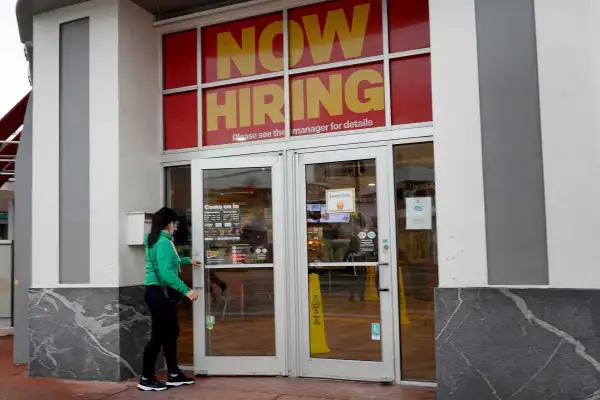Layoffs and Unemployment Are Reaching Record Lows. But the Numbers May Be Misleading

Despite the economic effects of the Omicron variant, it still appears to be a great time if you're looking for a new job. However, the jobs outlook may not seem quite so rosy in the near future.
The latest Department of Labor report, released Feb. 1, gives a snapshot of the job market in December. The data show that even as COVID-19 cases started to surge, the "Great Resignation" kept raging on, the number of job openings exceeded expectations, and layoffs shrunk to the lowest levels on record.
The Labor Department says that, in December, there were 10.9 million jobs open, 4.3 million workers quit, and that employers laid off only 1.16 million workers — the lowest number of layoffs ever recorded by the agency.
“Quits and openings both fell in December despite Omicron, but both are still elevated,” tweeted Daniel Zhao, a senior economist at Glassdoor. “This is a reminder that in part, the ‘Great Resignation’ can be easily explained by the tight job market, where more job opportunities for workers means more turnover.”
Meanwhile, separate Labor Department data show that the unemployment rate in a dozen states also reached record lows in December, while the national rate fell to 3.9%.
“This is, by so many measures, a historically tight labor market: record levels of job openings, of quits, wages are moving up at the highest pace they have in decades,” said Federal Reserve Chairman Jerome Powell during the Fed’s monetary policy meeting Jan. 26. “If you look at surveys of workers, they find jobs plentiful. Look at surveys of companies, they find workers scarce.”
While December’s data is promising, some economists, analysts and even the White House are suggesting that the Labor Department’s forthcoming jobs report on Feb. 4 won’t look so upbeat for the labor market.
Workers quitting in droves
According to the Labor Department, 4.3 million people quit their jobs in December. Economists say they’re not just tapping out. They’re often looking for higher-paying, more flexible jobs.
“More and more people left their jobs to find greener pastures as strong demand for workers resulted in a job switching boom,” Nick Bunker, a labor-market economist at Indeed, says in response to the new Labor Department data. “The result was wages growing at a rate the U.S. labor market hasn’t seen in well over a decade.”
In November, the number of people quitting their jobs hit an all-time high of 4.5 million. While the number of people who quit in December edged down slightly, it still remains historically high. For workers in the private sector, wages rose 5% in the 12-month period ending in December.
In short, the Great Resignation is still in full swing.
Shrinking unemployment rate
Also in December, the national unemployment rate fell to 3.9%, down from 4.2% the previous month and 6.5% the year prior. The lowest national unemployment rate ever recorded was 2.5% in 1953.
Labor Department data show that the unemployment rates of 12 states hit record lows in December, in some cases dropping below 2%.
Here are the states that had record-low unemployment rates in December:
- Arkansas (3.1%)
- Georgia (2.6%)
- Idaho (2.4%)
- Indiana (2.7%)
- Kentucky (3.9%)
- Mississippi (4.5%)
- Montana (2.5%)
- Nebraska (1.7%)
- Oklahoma (2.3%)
- Utah (1.9%)
- West Virginia (3.7%)
- Wisconsin (2.8%)
Overall, 24 states currently have unemployment rates lower than the national rate, 3.9%.
While these unemployment figures signal a strong recovery from earlier in the pandemic, they don't fully reflect the situation for everyone. For instance, the national unemployment rate for Black workers rose to 7.1% in December, up from 6.5% the previous month.
Similarly, many folks have dropped out of the workforce entirely during the pandemic. Compared to pre-pandemic levels, there were over 2.1 million fewer people in the workforce in December 2021. When people exit the labor force entirely and stop seeking jobs, they're not counted in the unemployment rates above, which may lead to artificially low official unemployment figures.
Omicron caveats
Overall, the Labor Department’s data for December paints a rosy picture. Layoffs are low. Unemployment is low. Quits are high. All good things for workers, but some economists — and even some folks in the White House — are foreshadowing a disappointing jobs report due this Friday.
This monthly jobs report — which calculates the unemployment rate and shows how many jobs the economy added each month — only looks at the week that includes the 12th of each month. So the current national unemployment rate from December is based on the week that includes Dec. 12, which is before cases started surging.
The upcoming jobs report for January, scheduled to be released this Friday, will look at the week including Jan. 12. That week overlaps with the time when the Census Bureau says nearly 9 million workers were out sick due to the coronavirus.
“We just wanted to prepare people to understand,” White House Press Secretary Jen Psaki said Monday, “[January’s] jobs report may show job losses in large part because workers were out sick from Omicron.”
Adding to the likelihood of a disappointing jobs report, private payroll company ADP released its own monthly report Wednesday, ahead of the government’s numbers. ADP’s report shows the private sector shed a net loss of 301,000 jobs in January, far below economist’s predictions of about 200,000 added jobs.
In a preview of the January jobs report, Zhao of Glassdoor says job losses are likely and the unemployment rate might jump upward.
“The January jobs report,” he writes, “is likely to show the job market getting off on the wrong foot in 2022.”
More from Money:
3 Best Money Moves for February
More Companies Are Wooing Workers by Paying off Their Student Loans
Employers Are Boosting 401(k) Benefits to Compete for Workers Amid the Great Resignation
